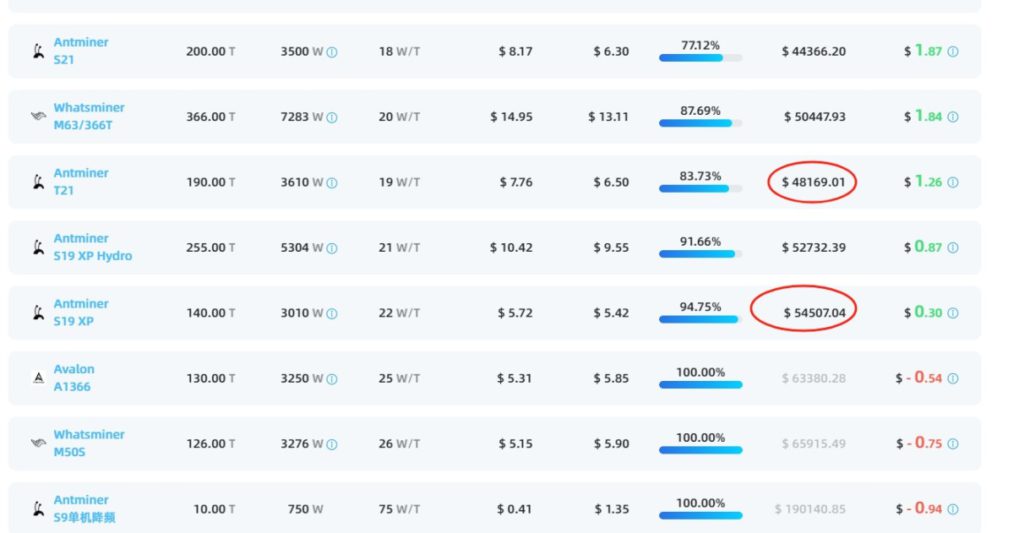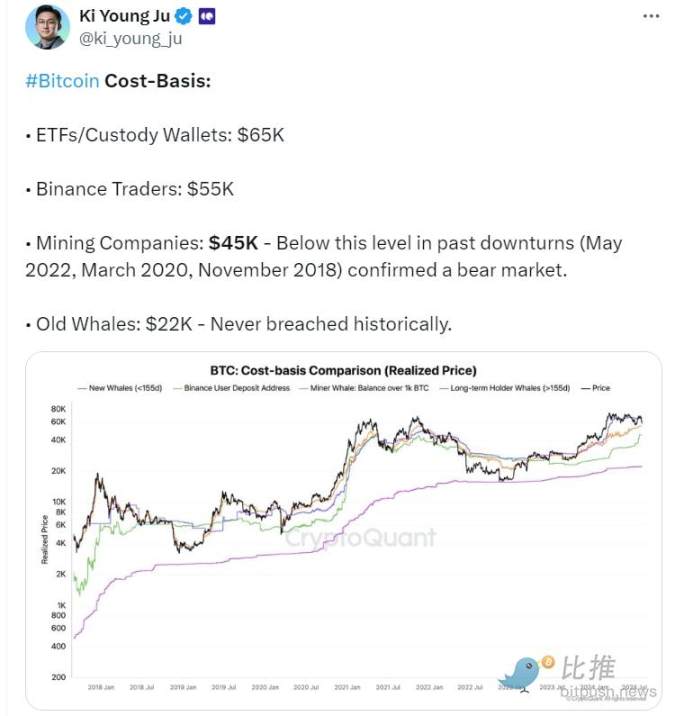On August 5, Bitcoin plummeted, many whale were liquidated, and the market was in mourning. As for the reasons for the market's plunge, many people blame the expected recession in the United States and the yen's interest rate hike, but they seem to have ignored the huge selling pressure inherent in itself. In addition, the market places too much emphasis on the impact of accidental factors on the development of the Bitcoin market trend. From the perspective of minimal resistance, such accidental factors only increase the depth of the crash. The author mainly focuses on the trend research of Bitcoin, and our previous articles are basically in line with the basic trend of Bitcoin. This article hopes to provide some Bitcoin trend analysis viewpoints without the influence of accidental factors from a trend perspective for readers' reference.
After Bitcoin turned around in July, $70,000 became an important obstacle
Between big drops and big rises, there are always various reasons that make users bullish or bearish, and this also forms the core of the long-short game. So when we talk about trend development, we must be clear about the length of the cycle we are talking about. If we look at the bull market as a whole, it is still difficult to say that the cyclical pattern of the bull market has been changed. In the future, this article will still focus on the bull market. From a macro perspective, although the recent U.S. employment data is not as good as expected, more data is needed to confirm the U.S. economic recession. It would be too hasty to completely turn short at this time. This article talks more about trend changes between weeks and months, which is also the feature of the author's previous trend research articles. Below, this article attempts to discuss the underlying reasons for this market decline from a trend perspective.
The author previously believed that the reason for the turnaround at the end of July mainly lies in two dimensions: 1. The analysis of the German government’s sell-off and the Mt. Gox sell-off; 2. The impact of Trump’s speech. Specifically, after the German government's sell-off ended, market panic subsided, but the market underestimated the selling pressure of retail investors when Mt. Gox paid out, and retail investors tended to chase highs and sell lows. With the stimulus of Trump's speech, the crypto market rebounded sharply. But when the market failed to effectively break through $70,000, the market bulls had already weakened.
Why does the author think that after Trump’s speech, Bitcoin will be available in August? There are three other indicators worth paying attention to. The first is that Wall Street institutions have lost momentum to increase their holdings after Bitcoin entered $70,000. This can be confirmed by its past history of increasing holdings. At present, the entire institution is still in the hoarding stage, and its willingness to raise prices wildly is not strong. In addition to this, Bitcoin miners started selling at $70,000. As early as June 13, CryptoQuant published an article on the When Bitcoin prices fluctuated between $69,000 and $71,000, miners stepped up their selling efforts. Data shows that on June 10, miners sold 1,200 Bitcoins through OTC transactions, setting the highest daily trading volume in two months. In addition, Bitcoin has seasonal characteristics in August, which is similar to the macro view.
The above three indicators have hinted at the weakness of the bulls to some extent. At this time, if there are negative factors in the macro view, it will be difficult to curb this decline. Other negative factors for the macro outlook include lower-than-expected employment data in the United States, rising interest rates in the Japanese yen, and the release of approximately 28,000 Bitcoins by the U.S. government. On this basis, 33,960 Bitcoins were allocated in the Mt Gox settlement agreement, and Genesis creditors distributed a value of 1.5 billion. For Bitcoin and Ethereum in the U.S. dollar, the selling pressure these days is difficult to resolve in the short term. This, coupled with the liquidation of whale, eventually caused the market to plummet.
A very accurate Bitcoin buy the dips indicator
The author believes that when Bitcoin reaches around $70,000 at the end of July, it is indeed difficult to make a short decision directly, but it is not difficult to do some hedging based on the above-mentioned trend research in order to wait for more favorable factors to appear. However, when Bitcoin plummets, there is a very accurate buy the dips indicator that is enough to support investors' active entry. That indicator is the miner shutdown price, which is a very accurate indicator under many rounds of bull and bear tests.
According to poolin data, the current shutdown price of the mainstream Bitcoin mining machine Antminer S19XP is $54,507, and the shutdown price of the Antminer T21 is $48,169. For Bitcoin, US$48,000-54,000 essentially forms a very important price support range. Especially after Bitcoin falls below US$63,000, investors should consider gradually building positions at this position. This is almost a price that does not require too much. A gradual buy the dips range can be confirmed by technical analysis and market analysis.

In addition to the above intuitive information, CryptoQuant CEO Ki Young Ju provided a statistical analysis worth referring to. On August 6, Ki Young Ju, CEO of CryptoQuant, posted on $45,000, a level below which during past market downturns (May 2022, March 2020, November 2018) confirmed a bear market; Old Whale: $22,000. As mentioned above, Bitcoin is still dominated by the bull market in terms of general trend, and from the perspective of mining machine prices, $45,000 is almost the limit of Bitcoin’s decline.

How Bitcoin will develop in the future
How will Bitcoin prices develop in the future? Judging from the current dominant factors, the U.S. megaconcept is still a major influencing factor. So, what do market big V think about the future development of the United States and Bitcoin?
Goldman Sachs CEO Solomon predicts that the Federal Reserve will avoid an emergency interest rate cut because he does not believe that the U.S. economy will fall into recession. "I don't expect to see any progress before September," Solomon said. "The economy is going to be steady and there may not be a recession. Based on the economic data we're seeing so far and the information coming out of the Fed, I think it's probably going to be this fall." There were one or two interest rate cuts."
Cryptocurrency analyst Alex Krüger posted on A financial crisis caused by the United States going into recession was much better. As for U.S. data, the focus right now is on the job market, so pay special attention to Thursday's initial jobless claims (not usually a market-moving data), as well as the State Employment data due out on August 16 , providing detailed state-level employment information, information that the market pays little attention to).
On August 6, 10x Research stated in its latest report that many people attributed the Bitcoin sell-off to the unwinding of the yen carry trade, but the reality is much more complicated. Bitcoin has been vulnerable since mid-March, remaining range-bound despite a 15% gain in the Nasdaq and a 10% depreciation in the yen during that period. The carry trade relies on continued high interest rates in the United States, which are unlikely to continue. The rules of the game have changed. In the past 24 hours, crypto market trading volume reached $244 billion, the highest level since March 6. Bitcoin experienced massive intraday liquidations on the day after reaching new all-time highs. Financial markets are like puzzle pieces that need to be reassembled periodically as new drivers of asset prices emerge, and this is one of those times. Unlike sharp declines in April and June that were mitigated by increased leverage, there may not be such a reversal this time.
On August 6, QCP Capital said in its latest analysis: As for the rumors of emergency interest rate cuts, QCP believes that this is unlikely because it will seriously damage the credibility of the Federal Reserve, exacerbate market panic, and make people believe that an economic recession is coming. In addition, yesterday's risk aversion wiped out a considerable amount of leverage. With prices plummeting, perhaps now is the time to consider accumulating spot BTC and ETH. It's certainly too early to tell whether the market has returned to normal. Although the VIX index has fallen from yesterday's peak of over 65, it is still above 30.
On August 6, Coinbase researcher David Duong said that market conditions on Tuesday indicate that as buying activity on centralized exchanges increases, a short squeeze may occur, which may lead to a market rebound in the next few days. In addition, Genesis issued Bitcoin and Ethereum in physical form in its bankruptcy liquidation plan; the unwinding of the yen arbitrage trade may also affect the current decision of Mt. Gox creditors to receive Bitcoin. The market's recent declines do not signal the beginning of a new long-term trend or market cycle.
Summarize
From a trend perspective, the upward pressure on Bitcoin is still relatively large. This mainly comes from the selling pressure of miners, the US government’s selling, and compensation from Mt. Gox and Genesis. This makes the upward pressure on Bitcoin very high. This will take a period of time. time for digestion. However, once Bitcoin enters the $48,000-$54,000 range, investors can essentially start buy the dips gradually. According to Goldman Sachs analysts, the Federal Reserve may cut interest rates one or two times this fall. This will essentially provide positive momentum for Bitcoin. In addition, as the U.S. election approaches, Trump's radical remarks will help repair market sentiment, thereby promoting the rise of Bitcoin. However, the author is more optimistic about the market conditions in the first half of next year. The core reason is that the market has digested the recent huge selling pressure, and the Federal Reserve's interest rate cuts will provide sufficient funds for the crypto market.







